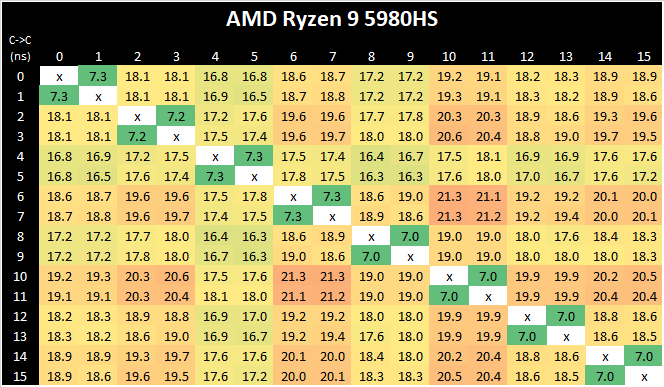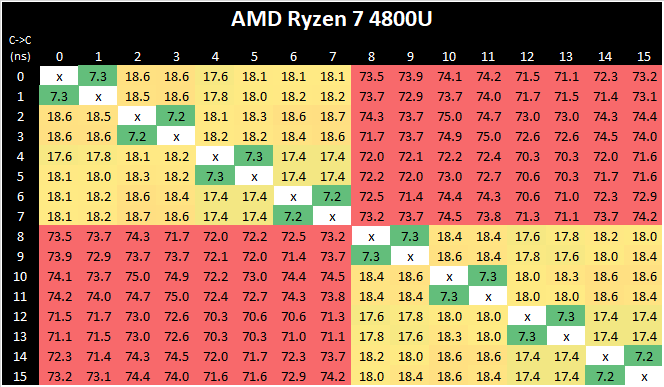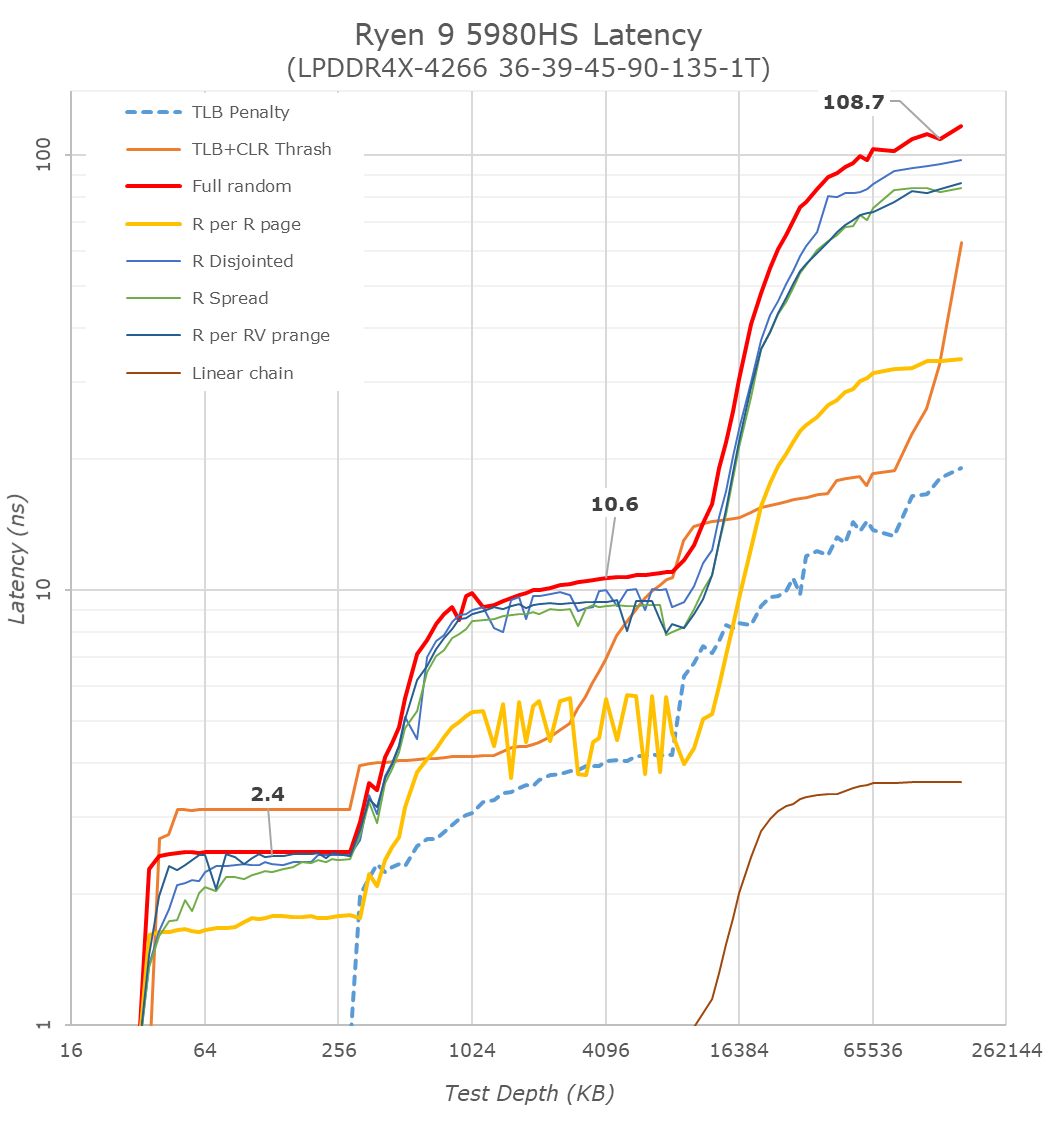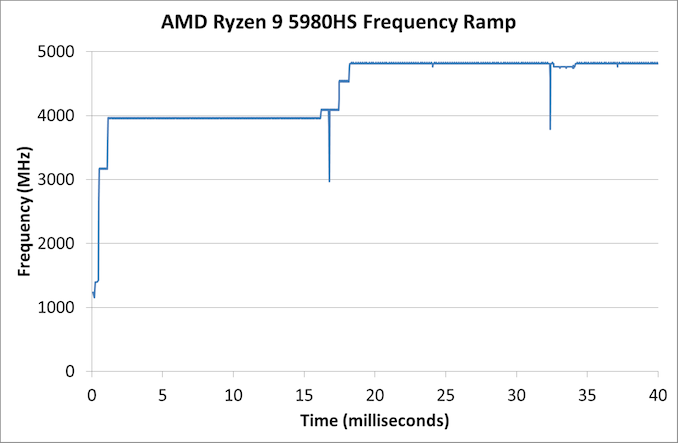AMD Ryzen 9 5980HS Cezanne Review: Ryzen 5000 Mobile Tested
by Dr. Ian Cutress on January 26, 2021 9:00 AM EST- Posted in
- CPUs
- AMD
- Vega
- Ryzen
- Zen 3
- Renoir
- Notebook
- Ryzen 9 5980HS
- Ryzen 5000 Mobile
- Cezanne
CPU Tests: Microbenchmarks
Core-to-Core Latency
As the core count of modern CPUs is growing, we are reaching a time when the time to access each core from a different core is no longer a constant. Even before the advent of heterogeneous SoC designs, processors built on large rings or meshes can have different latencies to access the nearest core compared to the furthest core. This rings true especially in multi-socket server environments.
But modern CPUs, even desktop and consumer CPUs, can have variable access latency to get to another core. For example, in the first generation Threadripper CPUs, we had four chips on the package, each with 8 threads, and each with a different core-to-core latency depending on if it was on-die or off-die. This gets more complex with products like Lakefield, which has two different communication buses depending on which core is talking to which.
If you are a regular reader of AnandTech’s CPU reviews, you will recognize our Core-to-Core latency test. It’s a great way to show exactly how groups of cores are laid out on the silicon. This is a custom in-house test built by Andrei, and we know there are competing tests out there, but we feel ours is the most accurate to how quick an access between two cores can happen.
AMD’s move from a dual 4-core CCX design to a single larger 8-core CCX is a key characteristic of the new Zen3 microarchitecture. Beyond aggregating the separate L3’s together for a large single pool in single-threaded scenarios, the new Cezanne-based mobile SoCs also completely do away with core-to-core communications across the SoC’s infinity fabric, as all the cores in the system are simply housed within the one shared L3.
What’s interesting to see here is also that the new monolithic latencies aren’t quite as flat as in the previous design, with core-pair latencies varying from 16.8ns to 21.3ns – probably due to the much larger L3 this generation and more wire latency to cross the CCX, as well as different boost frequencies between the cores. There has been talk as to the exact nature of the L3 slices, whether they are connected in a ring or in an all-to-all scenario. AMD says it is an 'effective' all-to-all, although the exact topology isn't quite. We have some form of mesh with links, beyond a simple ring, but not a complete all-to-all design. This will get more complex should AMD make these designs larger.
Cache-to-DRAM Latency
This is another in-house test built by Andrei, which showcases the access latency at all the points in the cache hierarchy for a single core. We start at 2 KiB, and probe the latency all the way through to 256 MB, which for most CPUs sits inside the DRAM (before you start saying 64-core TR has 256 MB of L3, it’s only 16 MB per core, so at 20 MB you are in DRAM).
Part of this test helps us understand the range of latencies for accessing a given level of cache, but also the transition between the cache levels gives insight into how different parts of the cache microarchitecture work, such as TLBs. As CPU microarchitects look at interesting and novel ways to design caches upon caches inside caches, this basic test proves to be very valuable.
As with the Ryzen 5000 Zen3 desktop parts, we’re seeing extremely large changes in the memory latency behaviour of the new Cezanne chip, with AMD changing almost everything about how the core works in its caches.
At the L1 and L2 regions, AMD has kept the cache sizes the same at respectively 32KB and 512KB, however depending on memory access pattern things are very different for the resulting latencies as the engineers are employing more aggressive adjacent cache line prefetchers as well as employing a brand-new cache line replacement policy.
In the L3 region from 512KB to 16 MB - well, the fact that we’re seeing this cache hierarchy quadrupled from the view of a single core is a major benefit of cache hit rates and will greatly benefit single-threaded performance. The actual latency in terms of clock cycles has gone up given the much larger cache structure, and AMD has also tweaked and changes the dynamic behaviour of the prefetchers in this region.
In the DRAM side of things, the most visible change is again this much more gradual latency curve, also a result of Zen3’s newer cache line replacement policy. All the systems tested here feature LPDDR4X-4266 memory, and although the new Cezanne platform has a slight advantage with the timings, it ends up around 13ns lower latency at the same 128MB test depth point into DRAM, beating the Renoir system and tying with Intel’s Tiger Lake system.
Frequency Ramping
Both AMD and Intel over the past few years have introduced features to their processors that speed up the time from when a CPU moves from idle into a high powered state. The effect of this means that users can get peak performance quicker, but the biggest knock-on effect for this is with battery life in mobile devices, especially if a system can turbo up quick and turbo down quick, ensuring that it stays in the lowest and most efficient power state for as long as possible.
Intel’s technology is called SpeedShift, although SpeedShift was not enabled until Skylake.
One of the issues though with this technology is that sometimes the adjustments in frequency can be so fast, software cannot detect them. If the frequency is changing on the order of microseconds, but your software is only probing frequency in milliseconds (or seconds), then quick changes will be missed. Not only that, as an observer probing the frequency, you could be affecting the actual turbo performance. When the CPU is changing frequency, it essentially has to pause all compute while it aligns the frequency rate of the whole core.
We wrote an extensive review analysis piece on this, called ‘Reaching for Turbo: Aligning Perception with AMD’s Frequency Metrics’, due to an issue where users were not observing the peak turbo speeds for AMD’s processors.
We got around the issue by making the frequency probing the workload causing the turbo. The software is able to detect frequency adjustments on a microsecond scale, so we can see how well a system can get to those boost frequencies. Our Frequency Ramp tool has already been in use in a number of reviews.
Our frequency ramp showcases that AMD does indeed ramp up from idle to a high speed within 2 milliseconds as per CPPC2. It does take another frame at 60 Hz (16 ms) to go up to the full turbo of the processor mind.














218 Comments
View All Comments
ToTTenTranz - Tuesday, January 26, 2021 - link
Is there any mention to the number and speed of PCIe lanes on Cezanne?I've been seeing reports of it only having x8 PCIe 3.0 lanes, which could present a problem to AMD's apparent goal of pairing Cezanne with discrete GPUs.
Also, I've read the explanation for the super weird resolutions chosen for the IGP tests, but it still comes off as rather irrelevant.
The author first claims the IGP is good for eSports, but then there are no eSports games being tested.
eSports is also apparently the reason the author is trying to pull >60FPS out of these SoCs, but I don't see a single title that anyone would want to play at those framerates.
The memory bandwidth limitation is also presented as a fact to be aware of, but then the author chooses very low render resolutions that are less likely to be impacted by memory bandwidth.
The Vega 8 at 2100MHz has a fillrate between the Xbox One and the PS4, a compute performance well above the PS4 and with LPDDR4X it has a memory bandwidth similar to that of the XBox One (without eDRAM).
IMO it would be a much more interesting procedure to test 8th-gen multiplatform games at resolutions and settings similar to the 8th-gen consoles, than trying to push Borderlands 3 to run at 90FPS at a 360p resolution that no one is ever going to enable.
The only useful result I see in there is FFXV at 720p medium.
Makaveli - Tuesday, January 26, 2021 - link
Why is apple silicon the "true challenge"I've already invested into the X86 eco system and all my software is there, why would I even consider an M1 regardless or performance?
And the same could be said for someone invested in the apple eco why would they even look at an x86 product?
pSupaNova - Tuesday, January 26, 2021 - link
Because a laptop that can run for hours/days with light use, is performant, does not need a fan is going to fly of the shelves.Watch Apple's market share explode as x86 users switch.
Ptosio - Tuesday, January 26, 2021 - link
I'm quite sure there'd be plenty Zen 3 designs that can run fanless for 10h+ with performance enough for 90% of users on the web/streaming/office etc. And that's before gets access to TSMC 5nm.For typical user invested in Windows/x86 software, there's still no compelling reason to switch to Apple silicon. Plus, at the price MacBooks go, you can get features unheard of in the Apple world, such as 4k OLED, touchscreen with stylus, 360 design, upgradable memory (affordable 32GB RAM and 4TB storage for less than Apple would charge for 8/1), discrete GPU with vast games' catalogue...
Not to take away from M1 superiority, but x86 is still simply good enough and would only get better.
Meteor2 - Thursday, February 4, 2021 - link
A typical user invested in x86 isn't going to change to Apple, no, but they're not the typical user. THE typical user is a lot more software-agnostic, and yes, ARM Apple is going to take marketshare. It's inevitable.Speedfriend - Wednesday, January 27, 2021 - link
Apple market share explode? That is hilarious. The average cost of a laptop sold last year was $400. Remind me what the cheapest Mac costs? Most purchasers have no idea about relative performance which is why they are still buying laptop with 8th generation Intel inside. Even battery life has little impact when x86 laptop claim to have up to 15 hours.Where Mac will take some share back is in professional designers where they had lost share over the past 5 years. But even then, the lack of multi monitor support may hamper that.
Deicidium369 - Wednesday, January 27, 2021 - link
Apple Market will expand slightly - but not from people moving from PC to Mac. People using a Mac by choice will continue to buy and use AppleThe hoops you need to jump thru for a 2nd monitor is kinda ridiculous - move designed to sell TB docking stations
Deicidium369 - Wednesday, January 27, 2021 - link
I get 12 or 13 hours from my Tiger Lake XPS13 - which is about 10 hours longer than I need...DigitalFreak - Tuesday, January 26, 2021 - link
IIRC, all their current mobile CPUs that support external graphics have 8 PCIe 3.0 lanes. That's more than enough for any dedicated GPU in a laptop right now.ToTTenTranz - Tuesday, January 26, 2021 - link
All current external GPUs have an immense bottleneck due to Thunderbolt 3.0 only using 4 PCIe 3.0 lanes.I don't know if Asus' 8x solution is enough, either.